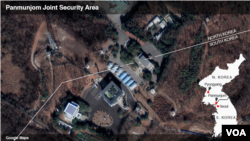Negotiators from North and South Korea, along with the U.S.-led United Nations Command, are holding their first talks Tuesday on demilitarizing a section of the heavily fortified border that separates the rival Koreas.
The talks will take place in the so-called Joint Security Area, which the three sides have controlled since the Korean War ended with a truce in 1953, leaving North and South Korea in a technical state of war.
During their third summit in Pyongyang last month, North Korean leader Kim Jong Un and South Korean President Moon Jae-in reached an agreement to disarm the JSA, including clearing mines buried within the small area, and removing guard posts, surveillance and other military equipment by the end of the year.
The Joint Security Area is the only spot within the Demilitarized Zone where troops from North and South Korea stand face-to-face. The area has long been used for diplomatic engagement. The JSA is also the scene of a bloody incident in 1976, when two U.S. Army officers were killed by ax-wielding North Korean soldiers.
During high-level talks Monday in the truce village of Panmunjom, the two Koreas agreed to begin a joint project to modernize and connect their rail and roadways before the end of the year. They also agreed to hold Red Cross talks related to families separated by the Korean War at the North's Mount Kumgang Resort in November.









